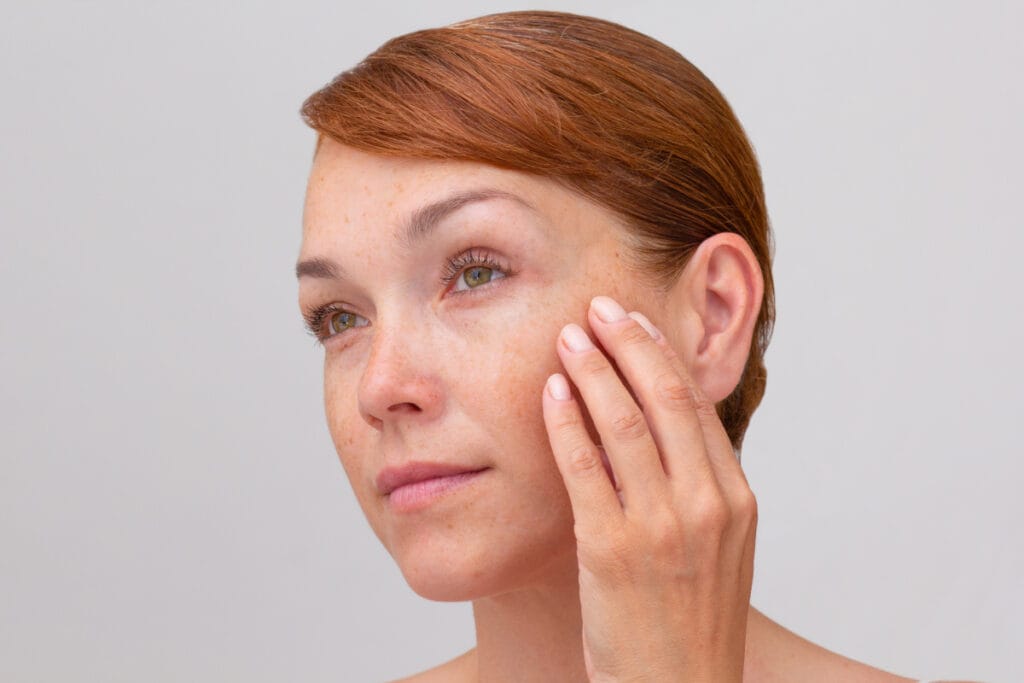Let’s talk about the ever-growing list of facelift buzzwords that have taken the cosmetic world by storm! Terms like “ponytail facelift,” “cat-eye facelift,” “mini facelift,” “deep plane facelift,” and “preservation facelift” have all entered the aesthetic lexicon, often leaving patients wondering how they differ from the traditional facelift—a surgical procedure that addresses wrinkles and loose skin in the lower face, jowls, and neck.
At Integrated Aesthetics, we believe that knowledge is key to making informed decisions about cosmetic surgery. Let’s take a closer look at the language of modern facelifts.
Ponytail Facelift
The “ponytail facelift” gets its name from the lifted, refreshed appearance you might achieve by pulling your hair up in a tight, high ponytail. Generally, plastic surgeons use the term ponytail facelift to refer to surgery that reverses signs of aging in the midface and cheeks, giving you a youthful, elevated look without drastic changes (and without affecting the neck or jawline).

Our take: The technique often involves shorter incisions, like a mini facelift (more on that below). And because it’s generally less comprehensive than a full facelift, the ponytail facelift can be a good fit for younger patients or those seeking early intervention before more significant signs of aging appear. Most patients we see require lifting in the neck, as well, for comprehensive, harmonious results.
The Cat-Eye Facelift (or, Fox-Eye Facelift)
A cat-eye or fox-eye lift targets the outer corners of the eyes, aiming for an elongated, almond-like shape. Using various methods—from sutures and threads to surgical lifting—can help those who want to address downward-turned eyes or drooping lids or achieve a more cat-like and youthful eye appearance.
Our take: While the cat-eye lift can offer a dramatic cosmetic effect, it is misleading to call it a facelift! This surgery may be more closely related to an eyelid lift or brow lift. Still, rather than asking for this procedure specifically, it is vital to discuss the outcome you want with a qualified, experienced plastic surgeon first and foremost. From there, they can recommend the ideal technique for your anatomy and goals.
The Mini Facelift
A mini facelift provides subtle rejuvenation by focusing on the lower face and jawline. It typically involves shorter incisions and less tissue manipulation than a full facelift, making it an excellent option for those with mild to moderate signs of aging who do not require the full effects of a facelift to reach their goals.
Our take: Because the surgery is less extensive, downtime and recovery are often shorter. Results tend to be more conservative, and thus better suited for patients in their 40s and early 50s who want a gentle refresh of early signs of aging rather than a dramatic transformation (or removal of excess skin).
The Deep Plane Facelift
A deep plane facelift goes beyond just tightening the superficial layers of the face. It involves lifting and repositioning the deeper facial structures and ligaments (the “deep plane”) to achieve more comprehensive, longer-lasting results. Unlike many of the trending terms in this list, the deep plane facelift is actually an established technique with several published studies about the technique.
Whether you are interested in a ponytail, deep plane, or preservation facelift, the right approach will always be the one that aligns with your individual needs and vision.
While this type of facelifting is a distinct technique, note that what some surgeons may call a “deep plane” may differ slightly from what another calls the same. Be sure to look at the surgeon’s before-and-after photos for a true sense of what they can accomplish with this (or any) technique!
Our take: This approach can deliver truly natural-looking rejuvenation. Lifting the facial tissues from a deeper level can address more pronounced sagging and restore youthful fullness, especially around the midface and cheeks. We recommend that patients pair this technique with skin resurfacing—especially laser, which can be performed while they are still under anesthesia—to address aging skin texture, as well, for a harmonious result. Many patients also benefit from a combined facial fat transfer.

The Preservation Facelift
The preservation facelift focuses on maintaining as much of your natural anatomy as possible. Instead of aggressively repositioning or removing tissues, it subtly reshapes and repositions them, aiming to preserve your unique facial structure and appearance.
Our take: This option appeals to those who value very natural results and seek to retain their authentic facial expressions and contours and achieve an age-appropriate enhancement. However, before taking such a subtle approach, we will go over before-and-after photos with our patients to learn what level of transformation appeals to them. In most cases, if you are making the investment of time and cost in a facelift, a natural-looking deep plane facelift will better achieve the effects you have in mind by creating a refined jawline while preserving most of your features (without any change in the upper face!).
The Non-Surgical or “Liquid” Facelift
Not everyone is ready for surgery! Non-invasive facelifts, accomplished with treatments like dermal fillers, Botox®, or energy-based skin tightening, can help maintain youthful contours and delay the need for a facelift. These treatments may also provide touch-ups or maintenance if you want to refine results after a surgical facelift.
Our take: While these options are incredible for younger patients and those with early signs of aging, it is impossible to achieve the results of a surgical facelift without surgery at this time. If we meet a patient who is hoping to address jowls, wrinkles, and crepe-like skin in the neck, we will almost always recommend a facelift.
Choosing the Right Facelift for You
Navigating these buzzwords and techniques can feel overwhelming! Whether you’re intrigued by a ponytail facelift, considering a deep plane or preservation facelift, or are more interested in non-surgical options, the right approach will always be the one that aligns with your individual needs and aesthetic vision.
A consultation is key to creating a tailored treatment plan based on your goals—not based on what you saw online.
That’s why a consultation with an experienced plastic surgeon is essential. At Integrated Aesthetics, Dr. Young Cho, Dr. Mihail Climov, or Dr. Melissa Chiang will assess your unique anatomy, discuss your goals, and recommend the best surgical (or non-surgical) plan for you. We serve both The Woodlands and Spring, Texas. Call (281) 404-5454 to get started today!









